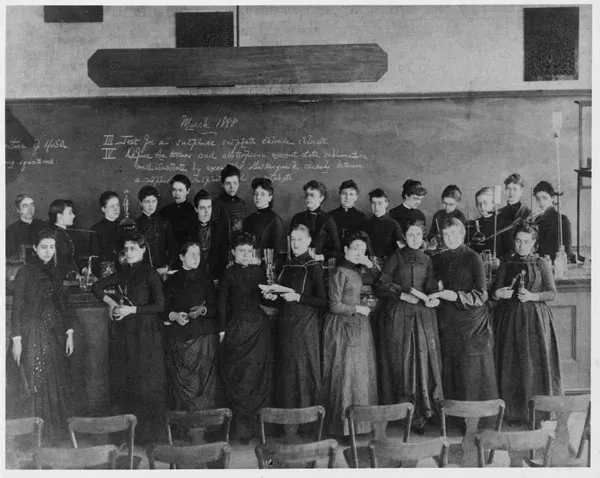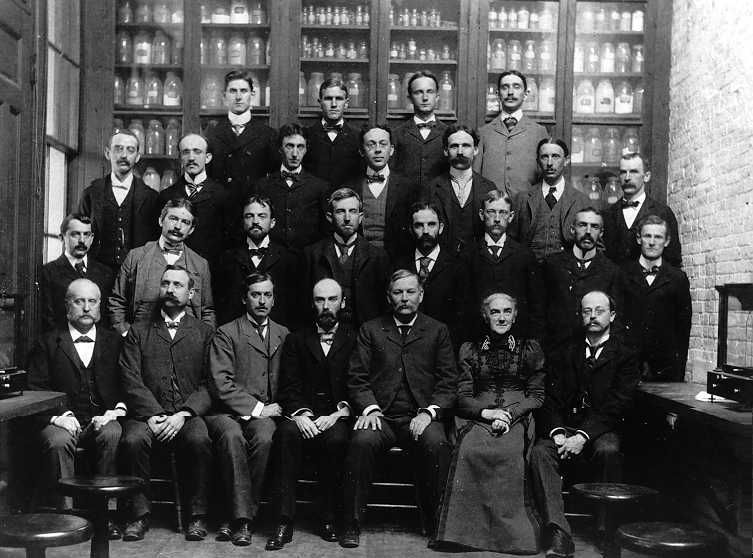The First Female Student at MIT Started an All-Women Chemistry Lab and Fought for Food Safety
Ellen Swallow Richards applied chemistry to the home to advocate for consumer safety and women’s education
:focal(891x403:892x404)/https://tf-cmsv2-smithsonianmag-media.s3.amazonaws.com/filer/8c/10/8c109b74-0cdc-498a-be6c-4d7b7ec8d380/ellenswallowrichards.png)
This past election cycle, hundreds of women ran for office on a promise to make the future brighter and more female. Many ran on platforms that made climate change a priority, asserting that the United States needed to take drastic action to protect our planet and our future. Women rallying behind environmental protection has deep roots: 150 years ago, chemist and public safety advocate Ellen Swallow Richards solidified the idea of “human ecology,” the study of how people shape their environments, and how their environments shape them.
Richards had initially planned to go into astronomy, but she found herself drawn again and again to more earthly aims. As the first female student at the Massachusetts Institute of Technology, she applied rigorous chemistry to the home, starting a movement to empower housewives to advocate for home safety. Upon finishing her undergraduate studies, Richards summed up her goal to use science for practical good in a letter to her parents: “My life,” she wrote, “is to be one of active fighting.”
For Richards, chemistry was the ideal tool for women to effect such change: It was scientific, practical and, most of all, relevant to daily life. After all, women had been experimenting with chemistry in the home all along, from understanding the chemical reactions required to make bread rise to the processes required to create a bar of soap. By harnessing the knowledge that women in the home already had and then applying scientific principles, Richards believed women would spark a change that would resonate beyond the kitchen table and transform society.
Born in 1842, Ellen Henrietta Swallow grew up on her family’s farm in Dunstable, Massachusetts, a rural area disconnected from the booming urban hub of Boston. She spent her childhood just beyond the boundaries of the farm, exploring the meadows, hills and streams, and she brought home plants and other treasures from her excursions to characterize in her diary. Her mother taught her writing and basic math, while her father, Peter, taught her history and logic. But Fanny and Peter knew their curious daughter needed more education. In 1859, the family moved to Westford where Ellen was able to attend Westford Academy, and she excelled in mathematics and Latin.
Peter opened a general store, where Richards worked beside him. Going from a self-sustaining farm life to one of supply-and-demand in the store, Ellen experienced first-hand the transition from domestic provisioning to the consumer-based manufacturing that had swept the United States with the Industrial Revolution. She observed the buying habits of customers and read food labels, taking note of ingredients and learning what they did on a chemical level and what function they served in the human body. The informal studies she undertook in her father’s store prefigured those she would initiate on a mass scale decades later.
By 1868, Richards had saved enough money to attend Vassar College, an all-girls school where she came under the mentorship of comet chaser and astronomy superstar Maria Mitchell. Mitchell was known for advocating for women’s education as ferociously as she chased celestial objects. Richards thrived in such an environment, taking more courses than her peers and dabbling in all of the sciences Vassar had to offer. But instead of turning her gaze to the stars, Richards eventually settled on chemistry, believing that it was more readily suited for practical application in the world around her.
When Richards left Vassar, she found the rest of the country much less willing to accept a woman scientist. She could not find anyone willing to hire a woman chemist, nor a university who would accept her for graduate study, save for one: MIT, which accepted her as a “special student.”
Domestic science, the first iteration of home economics, was just beginning to take hold in U.S. education, with the first official college course “Chemistry as Applied to Domestic Economy” at Iowa State College in 1871. Richards brought that movement to MIT, looking at the scientific principles of food and the domestic application of modern technology. She broke food down to its chemical components to learn its nutritional value and she experimented with different processes for food preparation. The same tasks that many women performed in their kitchens every day, Richards performed in a lab, affording the work of the serious scientist and the labor of the housewife equal status in the search for scientific truths.
Richards was thrilled to be pursuing her research at MIT, but the university had a different perspective. In his biography of Richards, Ellen Swallow, Robert Clarke writes that Richards was an “experiment” that the school’s administrators were certain was going to fail. They accepted her in order to show that women weren’t cut out for higher learning, in order to maintain their all-male student body status. As one faculty meeting observer recorded: “she was put on trial for all women.” Richards was treated like a pariah and relegated to a solitary lab. Circumstances were daunting, but Richards made the space her own by carrying out her interest in chemistry, particularly as it applied to the home.
When Richards applied to MIT’s doctoral program in chemistry, they rejected her application outright, but she continued to expand her own branch of domestic chemistry. Richards lobbied the governing board of MIT to allow her to accept women students into her lab. With the help of the Women’s Education Association, she raised the $2,000 required to open the lab, and in 1876, Richards welcomed 23 women, mostly local teachers, to her Women’s Laboratory. MIT still considered them “special students.”
That same year, Richards introduced America to a new way of thinking about the interaction between nature and the built environment. While accompanying her husband on a research trip to Germany, she learned of Ernst Haeckel’s theory of oekology, or ecology. Richards, unlike Haeckel, viewed ecology through the lens of sociology; instead of seeing humans as acting on nature, she saw humans as interacting with nature. Historian Barbara Richardson notes an important difference between Richards’ understanding of ecology and the larger scientific community: ecology expanded beyond biological systems to include a complex system of relationships that encompassed the home, the economic and the industrial. When industry threatened to disrupt the ecological social balance with economic or environmental inequity, Richards believed that an educated population had the power introduce balance back into the system.
Robert Musil, author of the book Rachel Carson and Her Sisters, writes that Richards can be thought of as a precursor to Carson’s later environmental activism. “Richards was very interested in how state and national legislation could be influenced by scientists and citizens,” he says. “She also saw that it was women who would create a movement.”
In 1878, Richards successfully persuaded the Massachusetts State Board of Health, Lunacy (Mental Health), and Charity to undertake a study of the state’s food supply in her Women’s Laboratory. For the study, she bought packaged food, brought it back to the lab, and broke it down to its component parts to uncover any adulterants that may be present. With the Food and Drug Administration a distant speck in the future, Americans faced the threat of illness every time they ate food from the store. In 40 cities around the state, Richards found all kinds of adulterated food, from sugar mixed with chloride to cinnamon powder laced with mahogany, sold at their full unadulterated price.
In 1879, her former mentor Mitchell sent her a letter to ask if Richards, now a leading voice in the consumer right-to-know movement, would meet with a new women’s club in Poughkeepsie, New York, to talk about the importance of women’s education. Richards accepted and was greeted by a crowd of 300 women. “The woman must know something of chemistry in self-defense,” Richards insisted. “It is for women to institute reform. … It is not an easy task we have before us. So long as we are content with ignorance, so long we shall have ignorance; but when we demand knowledge, because we know the value of knowledge, then we shall succeed.”
It seemed Richards was right. “If a dealer knows his articles are subjected to even simple tests, he will be more careful to offer the best,” Richards said to the women of Poughkeepsie. Four years later, Richards’ study of the state’s food supply led to the states’ passage of the first Food Purity Laws in the country—which required, among other things, for manufacturers to label correctly all food products. It would be more than 20 years before the federal Food and Drug Act of 1906 would come into being.
/https://tf-cmsv2-smithsonianmag-media.s3.amazonaws.com/filer/3a/72/3a723b56-317e-4303-9d7c-cd63624efc3e/esr011.jpg)
Also in 1882, Richards published her first book of many, The Chemistry of Cooking and Cleaning: A Manual for Housekeepers, which was meant to equip women with the “chemistry of common life.” In this book and the others that followed, she sought to teach white, middle-class housewives not only how to protect themselves from adulterated products, but also the importance of taking care of the society that they share with others. “The individual is one of a community influencing and influenced by the common environment,” she wrote in her book Sanitation of Daily Life.
Richards’ efforts continued to expand beyond MIT. In 1890, she and her friend Mary Abel opened The New England Kitchen, an open-door public kitchen intended to showcase modern cookery and domestic technology and to prepare nutrient-packed meals at low-cost to the working class and immigrant communities in Boston. Richards and Abel, however, were unable to fund The Kitchen, and after five months, it closed its doors.
Richards continued to rally more and more women around domestic science by tapping into the growing number of women’s clubs around the country. She gave speeches and implemented domestic science and chemistry courses in schools around Massachusetts. In 1899, she helped found the Lake Placid Conference (later renamed American Home Economics Association), a series of annual meetings organized by educators and activists around the goal of improving “living conditions in the home, the institutional household and the community.” The group, together with the American Public Health Association, successfully lobbied Congress to issue grants to the Department of Agriculture for increased investigations into the nation’s nutrition.
The many legislation and consumer movements of today that continue to protect people from manufacturers and corporations can trace their beginnings to Richards’ Women’s Laboratory. Yet because Richards’ ideas underlay these movements, it is important to acknowledge that she was a complex and imperfect figure; her advocacy often elided the realities and needs of the most vulnerable.
The concerns of middle-class white housewives that Richards spoke to did not mirror those of working-class women, who languished in substandard working conditions for low pay. Current scholars have criticized Richards’ New England Kitchen of scientifically prepared food as a means of imposing American values onto immigrant communities who preferred their own traditional foods. She further maligned immigrants and non-white people by positioning non-Christian religions in opposition to her progressive agenda, claiming in another book that “[n]ative religion is the greatest hindrance [to reform] in many lands.”
Richards made great strides, but she also may have perpetuated racist beliefs that non-Western people were backward and regressive. In one realm, however, she was right: Women do have the ability to bring change and balance to an unequal system. When women have access to education and resources and when their knowledge is valued, they have the power to shape society itself.

